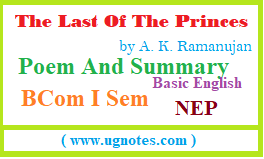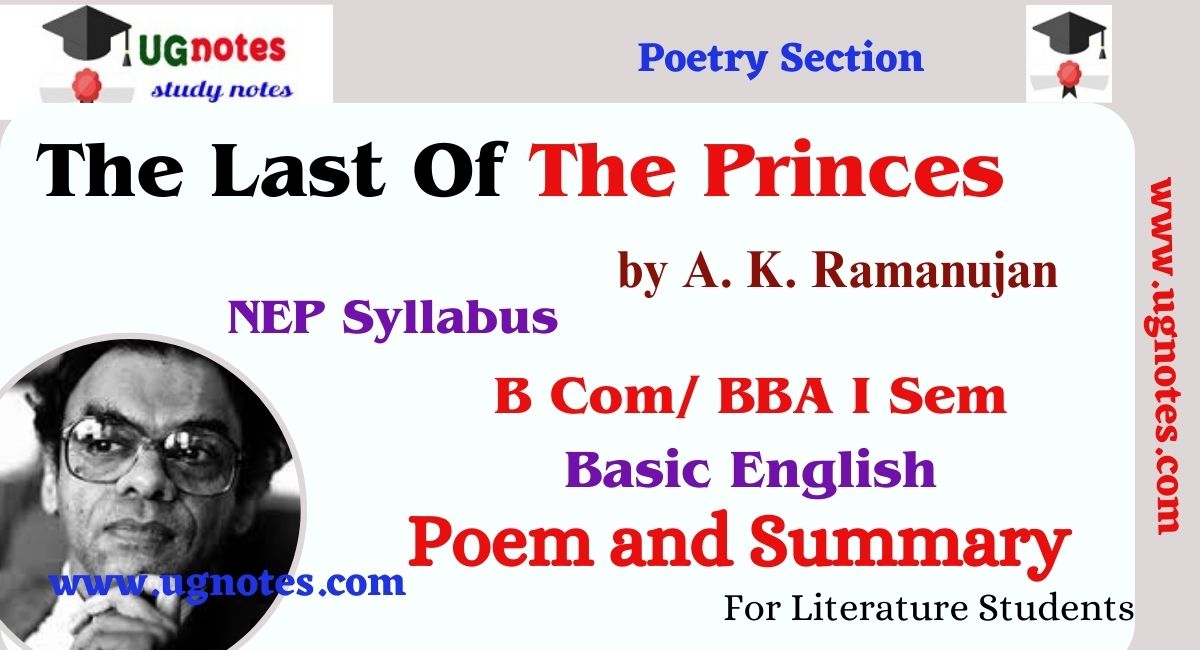The Last Of The Princes by A. K. Ramanujan.
B Com / BBA / BBM III Semester NEP Syllabus.
Gulbraga University , Raichur University, All State University.
The Last Of The Princes
by A. K. Ramanujan
About the Poet :-
Attipate Krishnaswami Ramanujan (16 March 1929 – 13 July 1993)was an Indian poet and scholar of Indian literature and Linguistics. Ramanujan was also a professor of Linguistics at University of Chicago.
Ramanujan was a poet, scholar, Linguist, philologist, folklorist, translator, and playwright. His academic research ranged across five languages: English, Tamil, Kannada, Telugu, and Sanskrit. He published works on both classical and modern variants of this literature and argued strongly for giving local, non-standard dialects their due. Though he wrote widely and in a number of genres, Ramanujan’s poems are remembered as enigmatic works of startling originality, sophistication and moving artistry. He was awarded the Sahitya Akademi Award posthumously in 1999 for The Collected Poems.
Poem Text
They took their time to die, this dynasty
falling in slow motion from Aurangzeb’s time:
some of bone TB,
others of a London fog that went to their heads,
some of current trends, iinported wine and women,
one or two heroic in war or poverty,
with ballads
to their name. Father, uncles, seven
folklore brothers, sister so young so lovely
the snakes loved her and hung dead,
ancestral
lovers, from her ceiling; brother’s many
wives, their unborn stillborn babies, numberless
cousins, royal mynahs and parrots
in the harem:
everyone died, to pass into his slow
conversation. He lives on, heir to long
fingers, faces in paintings, and a belief
in auspicious

snakes in the skylight: he lives on, to cough,
remember and sneeze, a balance of phlegm.
and bile, alternating loose bowels and hard
sheep’s pellets.
Two girls, Honey and Bunny, go, to school,
on half fees. Wife, heirloom pearl in her nose-ring,
pregnant again. His first son trainee
in telegraphy,
has telegraphed thrice already for money.
Summary of the poem :-
The poet takes the most powerful emperor, the Mughal Dynasty to exhibit the pathos in the mind of the readers. After the death of Aurangzeb, the last celebrated prince of the Mughal Dynasty, this mighty empire begun to decline. All the past glory was faded. The empire was divided into small regions. Gradually the British started overpowering on innocent Indians and on the then rulers. Their financial condition became worse.
Some of the princes died of bone tuberculosis other of cold climate while they led their life in utter luxury in London. some of them died of addiction of imported foreign liquor. In the pride they got married with the foreign girls. The native rulers considered it a status symbol to have white women as wife. There were quite a few rulers who met heroic death fighting against the British. Ballads have been written in praising their deeds. The princes lost their fathers, brothers, sisters, wives and their children. Sometimes their charming sisters committed suicide hanging them on the ceiling unable to bear the molestations of some rogues. The women used to keep mynahs and parrots in the harem. Every one of them died and remained as a historical memory.
But the last of the princes still survives. The poet now nicely paints the physical conditions of them. He inherits long fingers, painting-like face and blind belief in snakes. He constantly coughs and sneezes. Phlegm comes out his mouth. His liver is not functioning well. Sometimes he suffers from loose motion and sometimes constipation. Now he is so poor that he finds it difficult to provide formal education to his daughters, Honey and Bunny. They go to school only on half fees. His wife puts on a pearl nose-ring as a symbol of their past glory. All her heirlooms except the nose-ring have been sold to make ends meet. His eldest son is forced to take low-paid job as a trainee in the telegraph office. He has already telegraphed his father thrice for money. But his poor father is incapable to provide the demand for his dead-end condition. An undercurrent of pathos runs through the entire poem. Ramanujan has ironically attacked the snobbish mentality of the last princes, their bad habits, their intoxication to imported wine and wife and their unpatriotic fervor.
Frequently Asked Questions :-
What is the poetic style of AK Ramanujan?
His poetry abounds in boons of world and expression. Ramanujan generally writes in free verse without the importance of punctuation, but he does relatively frequently introduce rhyme and assonance into his poems. Another striking point of Ramanujan’s poetry is the ascendance in it of irony.
What is AK Ramanujan famous for?
Ramanujan wrote in both English and Kannada, and his poetry is known for its thematic and formal engagement with modernist transnationalism. Issues such as hybridity and transculturation figure prominently in such collections as Second Sight (1986), Selected Poems (1976), and The Striders (1966).
Which Mughal king is mentioned by the poet in the The Last of the Princes?
Bahadur Shah II, usually referred to by his poetic title Bahadur Shah Zafar (Persian pronunciation: [bahɑːduɾ ʃɑːh zafaɾ]; Zafar lit. Victory) was born Mirza Abu Zafar Siraj-ud-din Muhammad (24 October 1775 – 7 November 1862) and was the twentieth and last Mughal Emperor of India as well as an Urdu poet.
What is the theme of the poem The Last of the princes?
Explanation: ‘The Last of the Princes’ by great Indian poet A.K. Ramanujan is a depiction of the contrast of the past life and present life of princes in our country. It shows how the princes who were powerful once is thriving for their existence in the present life.
What is the poet in the poem?
A poet may simply be the creator (thinker, songwriter, writer, or author) who creates (composes) poems (oral or written), or they may also perform their art to an audience.








